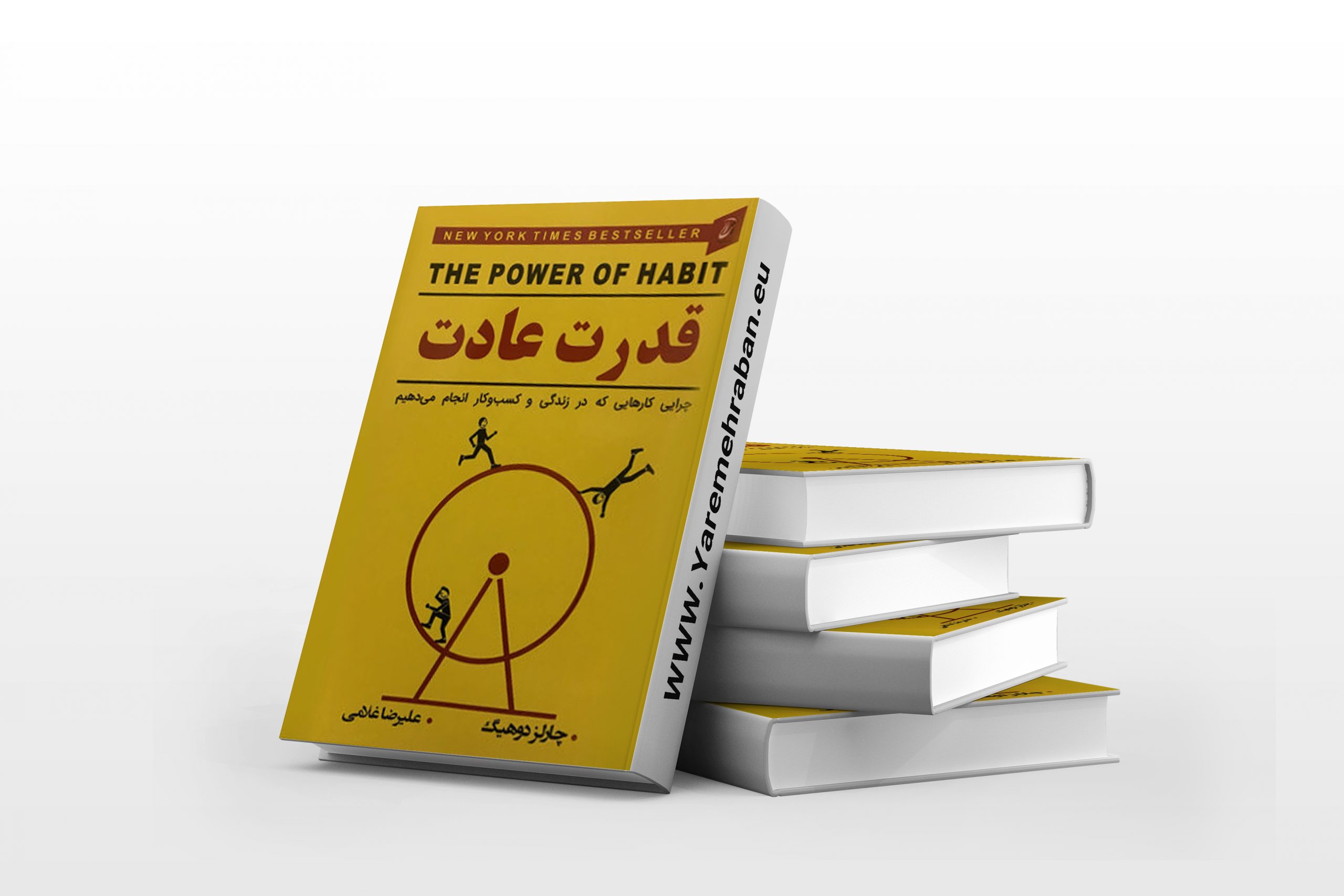Description
The Power Of Habit is a summary of hundreds of academic research, interviews with more than 300 scientists, executives, and research conducted in dozens of companies and organizations that have been on the New York Times bestseller list for about 62 weeks.
Introducing the book The Power of Habit by Charles Dahig
In the book The Power of Habit, Charles Dahig, the famous author and reporter, informs us of the shocking discoveries about the science of habits that teach us forever how to shape and change them.
This work is divided into three parts; The first part is devoted to how habits develop in people’s lives. This section examines the neuroscience of habit formation, how to make new habits, change old habits, and different methods of the process. For example, how brushing becomes an unusual national concern.
This section describes how Proctor & Gamble was able to turn customers’ habits into a multi-billion dollar business using an air freshener spray called fibrosis, or how the Association of Anonymous Addicts was able to attack habits at the height of their addiction. Change the lives of thousands and how the famous coach, Tony Dangi, was able to completely change the fate of the worst team in the American National Football League by focusing on the automatic reactions of his players to the subtle keys of the playing field.
The second section examines the habits of successful companies and organizations. This section details how Alcoa CEO Pavel O’Neill describes how, before becoming finance minister, he was able to move the declining company to the top of the Dow Jones Industrial Average, focusing on a pivotal habit, or how Starbucks was able to turn a rejected student into one of the world’s top executives by instilling habits designed to strengthen the will. This section explains that when the organizational habits of a hospital are wrong, even the most skilful surgeons may make irreparable and deadly mistakes.
The third section examines the habits of communities. This section describes how Martin Luther King Jr. and the civil rights movement succeeded in changing social habits in Montgomery, Alabama, and how a young pastor named Rick Warren was able to build the nation’s largest church in the Sedbeck area of California by focusing on changing those same habits. Make. At the end of this section we answer more complex moral questions, such as if a murderer in England can prove that it was his habits that led him to murder, he should be released.
In this book, Charles Duhigg focuses on habits that are clearly defined: choices that we all consciously make at a time; Then we do it every day without thinking about it. We have all consciously decided at some point in time how much to eat, how much to sleep, what to do first when we wake up, when to walk, and so on. Then we did not decide on any of these things anymore and that behavior became automatic in us, and this is a completely natural result from a neurological point of view. Now that we understand how this happens, we can reconstruct those patterns as we wish.
In a part of the book The Power of Habit, we read:
Do you want to develop a new eating habit? Researchers at the US National Center for Weight Control found that 78% of participants ate a specific breakfast every day (clues) in a project in which more than 6,000 people lost between 15 and 20 kilograms, but most succeeded in their diet. They had a specific reward for staying committed. The reward could be anything, a particular outfit, a sense of satisfaction and pride in going on the scales and losing weight, fitness or a summary of what they really wanted and carefully chosen.
Whenever they were tempted to break their diet, they focused on their reward until it became a mild obsession. Researchers have found that people’s desire for reward overcomes the temptation to break their commitment. This desire for reward established the habit cycle in them.
Knowing and understanding the science of tendencies is a vital issue for companies. There are many things we need to do on a daily basis, but they never become a habit. For example, we should watch our salt or sugar intake every day or drink plenty of water, we should also eat more vegetables and less fat every day, we should take vitamins every day and apply sunscreen. The need to get used to the latter is very clear: applying a small amount of sunscreen every morning greatly reduces the risk of skin cancer; Yet less than 10% of Americans use sunscreen every day while all of them brush their teeth every day. Why?
Index of the book
Introduction / Habit Treatment
Part One: People’s Habits
Chapter One: How Habits / Habits Work
Chapter Two: The Enthusiastic Brain / How to Build New Habits!
Chapter 3: The Golden Rule of Habit Change / Why Does Change Happen?
Part 2: Habits of Successful Organizations
Chapter Four: Paul O’Neill / Core Habits / Which Habits Are More Important?
Chapter 5: Starbucks and the habit of success / When willpower becomes automatic
Chapter 6: The Power of a Crisis / How Leaders Build New Habits in the Event
Chapter 7: How the Target Store Knows What You Want Before You Know It
Part 3: Habits of Communities
Chapter 8: Saddle Beck Church and the Montgomery Bus Sanctions / How the Moves Get Started
Chapter 9: Willpower Neurology / Are We Responsible for Our Habits?
Footnote: Tips for weight loss, smoking cessation, negligence and…
Attachment: A guide to using the contents of this book
About resources
The book The Power of Habit; A Road to Success
The book The Power of Habit helps the reader achieve success by discovering ways to do so, and teaches the reader what habits play a role in life. In the book Power of Habit, the author has carefully studied and analyzed habits and how they are formed. Charles Dahig seeks to answer the question of why we do certain things subconsciously out of habit and why we repeat them daily.
In the book Power of Habit, the contents are expressed in an attractive and attractive way. Each section is based on scientific and social research, and each section is presented in a narrative manner based on the actual experiences of eminent professors. In a simple and fluent way, this book provides tips and methods for changing the habits of its readers. The book has three sections: “Habits of Individuals”, “Habits of Successful Organizations” and “Habits of Communities”.
In the first part, Charles Dohig describes how habits originated and how the habit cycle is formed in people’s lives. In the second part, the author gives concrete examples of companies and organizations that have succeeded in achieving great progress by prioritizing and changing habits.
The third section, entitled Community Habits, examines how movements and habits are formed in communities. This book can be categorized in the category of books on personal transformation, psychology and social aspects, because in addition to helping individuals grow personally, it is also effective for the businesses of organizations and has many key points. On the back cover of the book The Power of Habit, Jim Collins, a well-known business thinker and strategist, praises the work and encourages people to read it.
Charles Dohig Successful New York Times Writer
Charles Dohig is an American journalist born in 1974. He won a Pulitzer Prize for nonfiction for his work as an editor and columnist, and wrote for the Los Angeles Times before joining the New York Times. The Power of Habit has been on the New York Times bestseller list for 2 years.
An article in the New York Times entitled “How Companies Find Out Your Secrets” is a summary of the book The Power of Habit. In addition to the best-selling book The Power of Habit, Charles Dohig has written another successful book, Smarter, Faster, Better.
Who should read The Power of Habit?
This book is suitable for people who do not have control over their habits and feel that these habits are on the path to their development and success. People who need to recognize their extraordinary power to break bad habits and have decided to try to change their old habits, it is better to read this book.
In The Power of Habits, Charles Dohig says that, in fact, weak people are victims of their habits and need to work harder to replace good ones with bad ones. This is the secret of successful people, they have tried to identify their bad habits and replace them with good ones. .
Successful people are in control of almost every single situation. But weak people have no control over their lives. Reading the book The Power of Habit allows the reader to establish good habits for success by doing the exercises in the book and putting in a lot of effort.
What is the habit formation cycle?
In part of the book, the author explains the three main elements of habit formation in a cyclical path:
“Stimulus or stimuli: Stimuli motivate a person to perform a specific action.
Action: Action refers to the reactions we give to stimuli.
“Reward: the feeling of joy or happiness we receive for doing something.”
Over time, this cycle works on its own, and the stimulus for action and reward are intertwined to give the person a strong sense of expectation and need, and eventually a habit. In fact, our habits are not created in a purposeful or premeditated way and may even be forgotten, changed or replaced. When the brain can not make a decision, it stops doing a lot of work or if the mind is focused on something else, a cycle of habits is formed.
Therefore, knowing how habits are formed, we should think about fighting bad habits and think about replacing them. Once we know the type of habits we form, we can more easily control bad habits and replace them with good ones. In The Power of Habit, Charles Dohig offers the reader precise and effective strategies for replacing and changing habits.
Change the habit, change the pattern
The human brain cannot tell the difference between good and bad habits, so when habits are encoded in our minds, bad habits cause the brain to respond to stimuli and rewards as much as good habits. Just as a person becomes accustomed to doing good behaviors and deeds, he also becomes accustomed to wrong and wrong behaviors. For example, a person who is accustomed to drinking soft drinks at every meal, has a pattern in his mind that he should eat this drink with food every day.
The book The Power of Habit says that if we recognize, learn, and repeat habits in the same way so that they can overcome previous habits and we can control the cycle, then we can turn bad habits into life experiences. When we replace a previous pattern with a new one, we are basically putting our mind into a new exercise to start another habit.
For example, instead of eating sweets every day, we eat an apple every morning. Our brain fails without a habit cycle and becomes involved in small, everyday issues. It should be noted that habits do not form quickly and are not replaced quickly. Only with practice and determination, patience and hard work can we be optimistic about a conscious change.
1- Introducing the book on YouTube
2- Introducing the book in Aparat












Reviews
There are no reviews yet.